Saruq Al Hadid Archaeology Museum
An ancient metallurgical mystery in the heart of modern Dubai
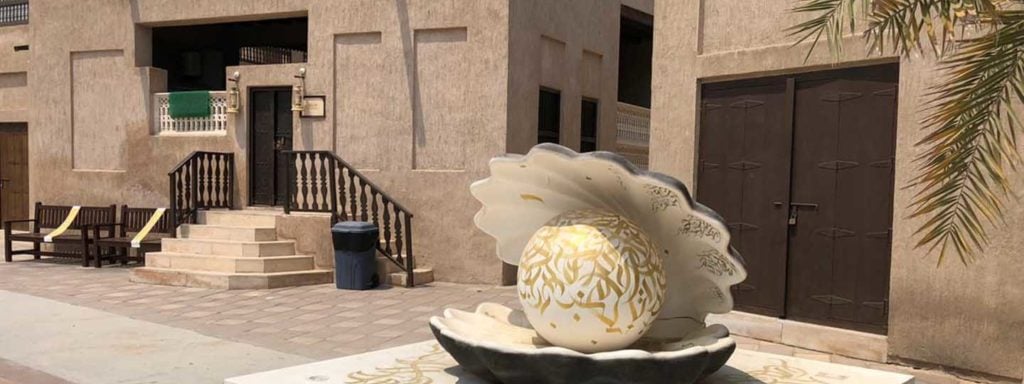

The Desert Speaks: A Forgotten Civilization Unearthed
In the vast and desolate Rub’ al Khali desert, where wind shapes the dunes into ever-shifting monuments of silence, a secret lay buried beneath the sands for millennia. It was in 2002, during an aerial inspection, that the Ruler of Dubai noticed unusual patches of dark soil in a remote desert region. What began as a curiosity would soon become one of the most significant archaeological discoveries in the Arabian Peninsula.
The site revealed a lost civilization—a highly sophisticated Iron Age culture that had mastered metallurgy and lived in organized communities. The name given to the site was Saruq Al Hadid, meaning “The Way of Iron.” Yet the true enigma lay not only in what they left behind—smelted slag, tools, weapons, and jewelry—but in where they left it. There were no known ore deposits nearby. No trees to fuel furnaces. No apparent reason why this place, deep in the arid desert, had become a metallurgical hub.
Bringing the Desert to the City: A Museum is Born
Rather than leave these treasures scattered in excavation pits, the city of Dubai decided to create a permanent home for them—one that would honor both their cultural significance and the spirit of discovery that had unearthed them. Thus, in 2016, the Saruq Al Hadid Archaeology Museum was inaugurated within a traditional wind-tower house in the historic Al Shindagha district.
This was no ordinary museum. Housed in a restored 1920s residence once belonging to Sheikh Juma bin Maktoum Al Maktoum, the museum was both a tribute to Dubai’s architectural heritage and a vessel for revealing the city’s prehistoric roots. Beneath wooden beams, coral stone walls, and hand-carved doors, a digital and interactive world awaited—where archaeology, storytelling, and modern design came together to reanimate a long-lost past.
Inside the Metalworking Mind: Slag, Fire, and Industry
The story of Saruq Al Hadid begins with metal. Massive quantities of slag, or industrial waste from smelting, were found strewn across the original excavation site. This pointed to a thriving metal industry, capable of forging tools, ornaments, and weapons in great numbers. But without nearby ore or fuel sources, why was such a facility here?
Inside the museum, visitors come face-to-face with artifacts that spark this question. Bimetallic daggers that show layers of copper and iron, precise tools with handles long vanished, and decorative objects that speak to status and ritual. Through the displays, one senses the rhythm of a lost industrial world—the roar of fire, the hiss of molten metal, the clang of work in the desert heat.
Interactive exhibits allow guests to see how metals were extracted, refined, and forged. Projections on sand simulate ancient furnaces, while glass cases show the residue of tools never seen for thousands of years. You don’t simply look at history—you step into it.
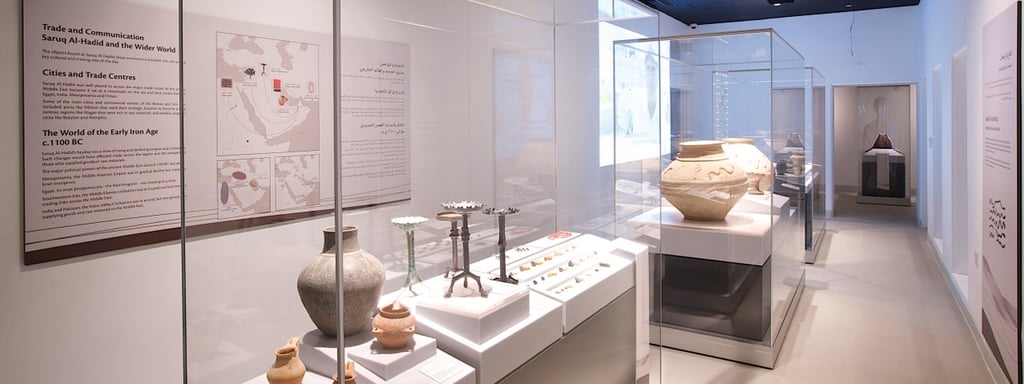

The Snake and the Seal: Symbols of a Belief System
Among the most mysterious finds at Saruq Al Hadid are the snakes. Dozens of coiled serpent figurines have been discovered, sculpted in metal, carved in ceramic, and painted on pottery. Their recurring presence suggests a spiritual or symbolic role—perhaps the snake was a guardian, a deity, or a totem in rituals performed by the metalworkers.
The museum curates this symbolic layer with care. Dedicated rooms explore the meaning of these creatures and their use in religious ceremonies. Alongside them are seals—tiny inscribed tokens bearing the marks of trade, authority, or faith. Some show geometric shapes, others have human or animal motifs. Each one invites speculation. Who wore them? What did they signify? How far did their influence stretch?
This glimpse into belief systems is one of the museum’s greatest strengths. It does not merely present the technological facts of metallurgy—it delves into the intangible world of meaning, myth, and ritual that surrounded it.
A Story Told Through Trade
Despite being isolated in the desert, the community of Saruq Al Hadid was anything but disconnected. Jewelry made from carnelian stones, likely imported from the Indus Valley, and tin, which had to come from distant regions, offer proof of long-range trade routes. Pottery styles and seal shapes suggest links to Mesopotamia, the Levant, and the Gulf.
Interactive maps in the museum trace these ancient trade routes, helping visitors understand how a seemingly remote site functioned as a node in a much larger regional network. The desert becomes less an obstacle and more a conduit—a place through which goods, ideas, and beliefs flowed like the veins of a great circulatory system.
Ancient Beasts and Everyday Life
While metallurgy dominates the narrative, the museum also paints a vivid picture of everyday life. Excavations yielded tens of thousands of animal bones—remnants of camel, oryx, gazelle, and fish. These remains tell of diet, domestication, seasonal hunting, and perhaps even ceremonial feasting.
Through detailed dioramas and bone reconstructions, the museum recreates the ecological backdrop of ancient Saruq Al Hadid. Visitors are reminded that the desert of 3,000 years ago was not the parched landscape it is today. Water sources, vegetation, and wildlife once supported communities, animals, and agriculture.
In these rooms, children marvel at reconstructed camel skeletons and digital timelines that bring creatures of the past to life, while adults gain a deeper appreciation of the region’s ecological transformation over the millennia.
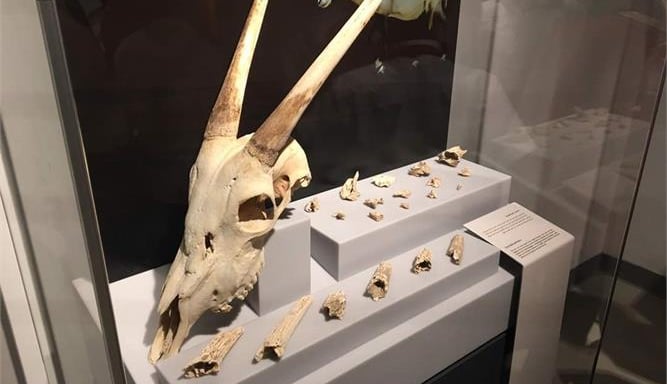

The Museum Experience: Ancient Knowledge Meets Modern Technology
One of the most striking aspects of the Saruq Al Hadid Museum is its seamless fusion of old and new. Walking from room to room, visitors engage with holograms, motion-activated displays, interactive excavation games, and digital sandboxes that mimic real archaeological digs.
The museum offers more than passive observation—it allows guests to participate. You can try your hand at matching artifacts to their historical use, reconstruct pottery shards, or follow the animated journey of a carnelian bead from South Asia to the Arabian desert.
Touchscreens provide detailed explanations in multiple languages, while visual timelines and animated guides ensure accessibility for all ages. There is a particular focus on making the experience educational and engaging for children, with story trails and treasure hunts that turn learning into play.
A House That Tells Many Stories
Beyond its contents, the museum building itself is a cultural artifact. It whispers of Dubai's not-so-distant past, when wind towers cooled homes and courtyards were the center of life. The structure has been lovingly preserved, with traditional architecture serving as a vessel for futuristic presentation.
This blend is symbolic. Just as Saruq Al Hadid links ancient desert craft to global networks, the museum building links the city's present to its roots. From within these coral walls, a forgotten civilization is remembered—and in that memory, modern Dubai finds depth, identity, and pride.
Events, Education, and Living Heritage
The Saruq Al Hadid Museum is not only a place of preservation—it is also one of learning and dialogue. Educational programs for schools, guided tours for scholars, and seasonal workshops ensure the space remains alive. Children can learn how archaeologists identify bones. Students can explore metallurgy through experimental smelting. Researchers can consult with ongoing excavation teams and updated artifact registries.
Temporary exhibits refresh the core offering, with special focus given to new discoveries at the site, rotating collaborations with regional museums, and public lectures that dive deeper into specific themes such as ancient spirituality, Iron Age trade, or desert ecology.
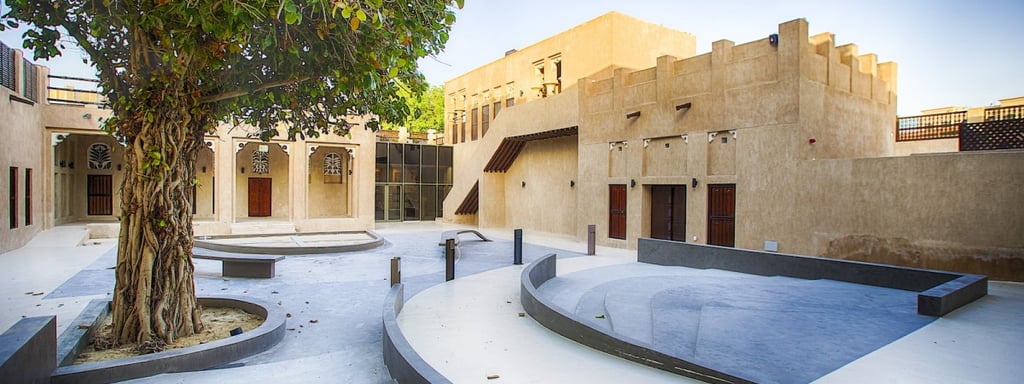

Visiting Saruq Al Hadid: A Practical Guide
The museum is located in the historic Al Shindagha district, just steps from Dubai Creek. It is easily accessible by metro via the Al Ghubaiba station, or by traditional abra from the Deira side. Visitors can also drive and park nearby.
It is open daily, typically from 8:00 AM to 8:00 PM, though hours may vary during Ramadan and holidays. Entry is modestly priced, with discounts available for students, families, and people of determination. UAE nationals and children often enjoy free admission.
The museum is fully accessible, with ramps, elevators, and friendly staff available to assist visitors of all mobility levels. Audio guides, printed materials, and digital tablets help ensure everyone has a fulfilling experience.
There is a small gift shop selling books, replicas, and educational toys, and the surrounding district includes several cafés and cultural sites such as the Sheikh Saeed Al Maktoum House and the Dubai Heritage Village.
A complete visit typically takes between 90 minutes and two hours, depending on your pace and interest level.
Final Thoughts: The Future Woven Through the Past
The Saruq Al Hadid Archaeology Museum is a gift from the desert. In a city renowned for its skyscrapers, it is a grounding force—reminding us that long before Dubai became a beacon of global innovation, it was already a place of creativity, resilience, and far-reaching ambition.
It is a museum that does not lecture—it invites. It does not simply display—it immerses. And it does not aim to preserve the past in amber—but to let it breathe, evolve, and inspire.
In the glint of ancient gold, in the rusted beauty of old tools, and in the silent wisdom of broken bones, we find not only the legacy of a forgotten people—but the enduring rhythm of life itself.
